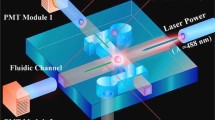Abstract
A compact system for remote and non intrusive in situ analysis of fluorescent tracers using a newly developed pulsed microchip laser coupled to fiber optics was used for in situ rhodamine determinations. By using a crystal doubling in front of the microchip Nd-YAG laser, it is possible to obtain 532 nm at 5 kHz with an energy of 0.6 μJ in a 0.5 ns pulse. Using fiber optics and a passive optode, it was possible to analyze remotely the fluorescence of rhodamine with a compact detection system (monochromator and photomultiplier). Limits of detection down to 10–10–10–11 mol/L can be reached depending on the rhodamine studied. Such a laser can be directly implanted in the optode avoiding laser losses when exciting in the U.V.
Similar content being viewed by others
Author information
Authors and Affiliations
Additional information
Received: 30 July 1997 / Revised: 6 October 1997 / Accepted: 10 October 1997
Rights and permissions
About this article
Cite this article
Moulin, C., Vitart, X. Pulsed microchip laser induced fluorescence for in situ tracer experiments. Fresenius J Anal Chem 361, 81–85 (1998). https://doi.org/10.1007/s002160050838
Issue Date:
DOI: https://doi.org/10.1007/s002160050838




